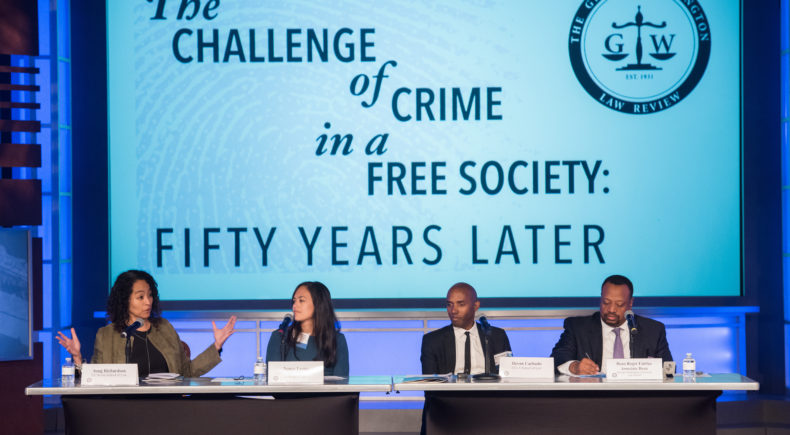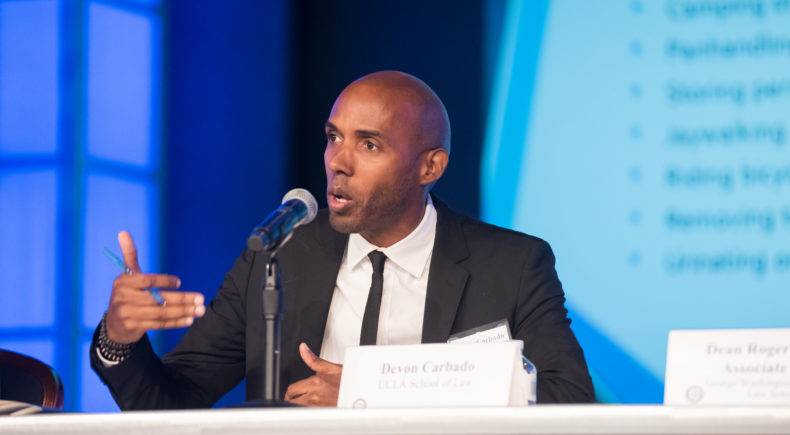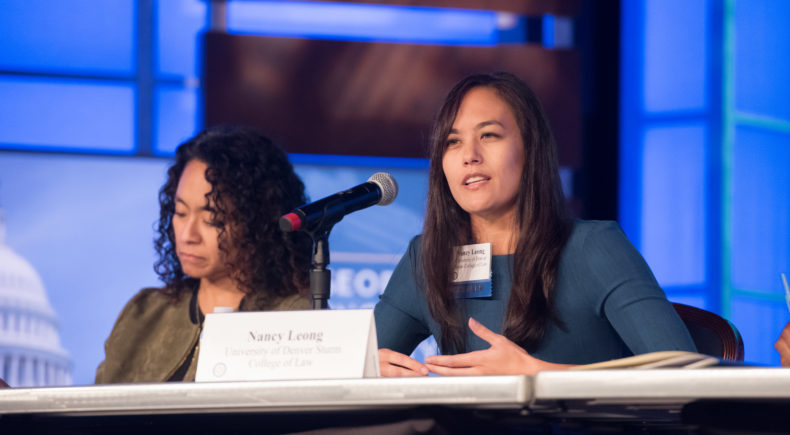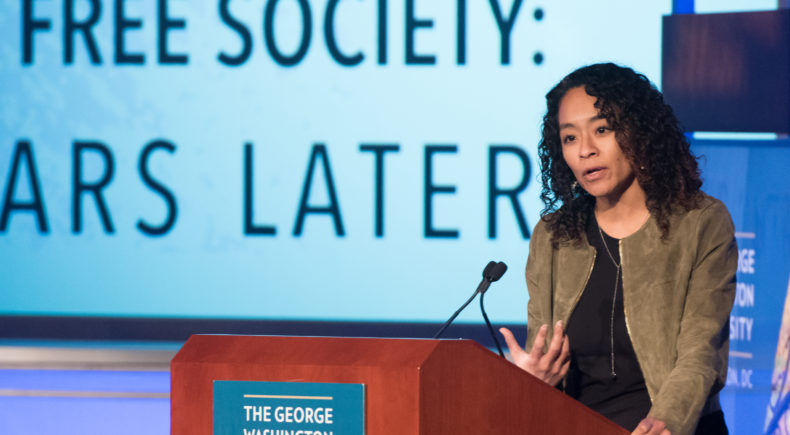Symposium 2017 | Police Violence and the Fourth Amendment
The first panel of The George Washington Law Review Symposium, “Police Violence and the Fourth Amendment,” was moderated by Professor Roger A. Fairfax, Jr., Jeffrey and Martha Kohn Senior Associate Dean for Academic Affairs and Research Professor of the George Washington University Law School and Director of the GW Criminal Law Initiative.
The first panelist, Professor Devon Carbado, Honorable Harry Pregerson Professor of Law of the UCLA School of Law and Associate Vice Chancellor of BruinX, presented on “The Fourth Amendment: From Stopping Black People to Killing Black People with One Amendment.” Professor Carbado argued that police violence against African Americans is a structural phenomenon. Instead of focusing on individual police officers or individual victims of police violence, we must broaden the framework to understand the structural phenomenon underlying police violence. Professor Carbado argued that increased police contact creates a possibility for police violence. If you are outside the zone of police contact, then you are outside the zone of police violence.
Further, Professor Carbado explained the interaction between police violence and the legal system: there is often (1) justifiable force, which can take the form of prosecutors deciding not to bring charges, grand juries deciding not to indict, triers of fact deciding that the act of police violence was reasonable, etc.; (2) qualified immunity and indemnification, which creates barriers to holding individual police officers liable (thus, even when a plaintiff wins, the police officer often pays nothing because the city indemnifies); and (3) difficulty in holding police departments liable.
Finally, Professor Carbado posited that the Fourth Amendment facilitates contact between the police and African Americans. Without triggering the Fourth Amendment, officers can engage in activities such as following, approaching, questioning, requesting identification or immigration status, much of which is racially motivated. However, the fact that these are racially motivated activities is irrelevant to the requirements of the Fourth Amendment. The officers only need probable cause to justify such activities under the Fourth Amendment, and probable cause can be as insignificant as a traffic infraction, such as loud unnecessary honking, driving too slowly, following too closely, etc. In sum, Professor Carbado urged us to not only consider the after-the-fact phenomenon of police violence, but the structural phenomenon of how police contact and the Fourth Amendment create pathways to police violence in our legal system.
The second panelist, Professor Nancy Leong, Professor of Law of the University of Denver Sturm College of Law, argued that police departments should hire more women officers to alleviate the problem of police violence in our society. She engaged the audience in a thought experiment: what if the police force were 50% women? How would police interact with the communities that they serve? According to a Pew research poll, women represented only about 13% of the police force in 2013, and only about 3% of leadership roles were held by women. Compared to their male counterparts, only 5% of complaints of excessive force were about women police officers (these statistics only account for officers in field assignments, excluding any women at desk jobs), implying that if a greater proportion of the police force were composed of women, there would be fewer incidences of police violence.
To those wondering, “wouldn’t there be physical difficulties for women entering the police force?” Professor Leong provided some statistics to alleviate those concerns. From studies on professional athletes, Professor Leong pointed out that in non-testosterone driven sports, such as fencing, wrestling, and shooting, female athletes could compete successfully against similarly-built male athletes. Note that these types of sports were all combat-relevant activities. Professor Leong, by making these arguments, does not intend to play into the stereotype that women are more gentle; rather, she makes her argument based on the fact that we live in a society where everyone is socialized differently, so diversifying the police work environment may improve social interactions between the police and the public.
To conclude, Professor Leong provided five primary reasons to increase the presence of women in police departments: hiring more women would (1) reduce excessive force overall based on previously mentioned statistics; (2) decrease expenses in settling or litigating cases of excessive force; (3) better reflect the make-up of the world’s population (50% women), allowing officers to better relate to suspects and the communities that they serve; (4) decrease sexual harassment and abuse cases by police officers (based on fewer sexual harassment/abuse complaints filed against female officers); and (5) change the culture of police departments overall. As a final note, you can follow Professor Leong on Twitter @nancyleong.
The last panelist, Dean Song Richardson, Interim Dean and Professor of Law of the University of California Irvine School of Law, first focused on the individual in police violence scenarios. She defined racial anxiety as a response to a situational threat, specifically where one anticipates engaging with a person of a different race. For police officers, this racial anxiety often manifests itself as fear that he/she might, in the course of the interracial interaction, confirm the stereotype that he/she, as a police officer, is racist; this is cognitively depleting and can result in poor decision-making. According to Dean Richardson, sociological studies have also shown that the higher the officer’s racial anxiety, the more likely it is that he/she will shoot young black men. In addition to the cognitive impact of racial anxiety, this result is driven by the police officers’ perception that they are not granted legitimacy by communities of color, and therefore must rely more on force than on their moral authority.
Dean Richardson then turned to the systemic, institutional piece. She argued that suspicion cascades, which are systematic and predictable decision-making errors, combined with institutional practice, criminal justice policies, and the Fourth Amendment, lead to police violence. Examples of criminal justice policies include (1) the war on drugs, which encourages police officers to interact more frequently with citizens; and (2) police management practices, which refer to the use of proxies, such as the number of stop-and-frisks or arrests, by supervisors who cannot directly oversee their rank and file. Dean Richardson also described the real-world effects of U.S. Supreme Court rulings on Fourth Amendment issues.
Combining the issues discussed above, Dean Richardson paints a disturbing picture of how Fourth Amendment law works in practice: (if you are experiencing racial anxiety,) you can walk away from a police officer if he/she does not have reasonable suspicion or probable cause; but if you walk away, the Supreme Court allows a police officer to follow you, without probable cause, (likely increasing your racial anxiety); and in a “high-crime” neighborhood, if you begin to run (likely due to heightened racial anxiety), an officer then is deemed to have “reasonable suspicion” and may proceed to take forceful actions against you, resulting in police violence.
This summary was authored by Law Review member Jacqueline Yap.




